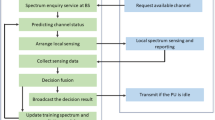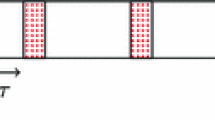Abstract
In this paper, the hybrid spectrum access and prediction techniques are exploited simultaneously in the high-traffic cognitive radio communication system, in order to enhance the throughput and overcome the problem of waiting states. The hybrid spectrum access is responsible for throughput enhancement by escaping the waiting states whereas the spectrum prediction alleviates the sensing errors in the high-traffic communication environment. The closed-form expression for the throughput of cognitive user (CU) communication is derived and validated the proposed approach with the reported literature. Moreover, a new framework is proposed to conquer the sharing issues of conventional and proposed approaches. In addition to this, the performance metrics of proposed framework such as the data-loss, energy-loss of the CU and interference at the PU have been analyzed.









Similar content being viewed by others
References
Alkyldiz, I. F., Lee, W.-Y., Vuran, M. C., & Mohanty, S. (2006). NeXt generation/dynamic spectrum access/cognitive radio wireless networks: A survey. Computer Networks, 50(13), 2127–2159.
Ghasemi, A., & Sousa, E. S. (2007). Fundamental limits of spectrum-sharing in fading environment. IEEE Transactions on Wireless Communications, 6(2), 649–658.
Mitola, J., & Maguire, G. Q. (1999). Cognitive radio: Making software radio more personal. IEEE Personal Communication, 6(4), 13–18.
Haykin, S. (2005). Cognitive radio: Brain-empowered wireless communications. IEEE Journal on Selected Areas in Communication, 23(2), 201–220.
Thakur, P., Singh, G., & Satasia, S. N. (2016). Spectrum sharing in cognitive radio communication system using power constraints: A technical review. Perspectives in Science, 8, 651–653.
Khoshkholg, M. G., Navaie, K., & Yanikomeroglu, H. (2010). Access strategies for spectrum sharing in fading environment: Overlay, underlay and mixed. IEEE Transactions on Mobile Computing, 9(12), 1780–1793.
Sharma, S. K., Chatzinotas, S. and Ottersten, B. (2014). A hybrid cognitive transceiver architecture: Sensing throughput tradeoff. Proceedings cognitive radio wireless networks and communications (CROWNCOM), Oulu Finland (pp 143–149).
Jiang, X., Wang, K. K., Zang, Y., & Edwards, D. (2013). On hybrid overlay-underlay dynamic spectrum access: Double-threshold energy detection and Markov model. IEEE Transactions on Vehicular Technology, 62(8), 4078–4083.
Pandit, S., & Singh, G. (2014). Throughput maximization with reduced data loss rate in cognitive radio networks. Telecommunication Systems, 57(2), 209–215.
Verma, G. and Sahu, O. P. (2016). Intelligent selection of threshold in cognitive radio system. Telecommunication Systems (Online). DOI: 10.1007/s11235-016-0141-y.
Thakur, P., Kumar, A., Pandit, S., Singh, G. and Satasia, S. N. (2016). Frame structures for hybrid spectrum accessing strategy in cognitive radio communication system. Proceedings IEEE international conference on contemporary computing (IC-3), Noida.
Thakur, P., Kumar, A., Pandit, S., Singh, G., & Satasia, S. N. (2016). Advanced frame structures for hybrid spectrum accessing strategy in cognitive radio communication system. IEEE Communication Letters. doi:10.1109/LCOMM.2016.2622260.
Jian, Y., & Hang-Sheng, Z. (2015). Enhanced throughput of cognitive radio networks by imperfect spectrum prediction. IEEE Communication Letters, 19(10), 1338–1341.
Pei, E., Liang, Y., KC, T., & Li, K. (2011). Energy-efficient design of sequential channel sensing in cognitive radio networks: Optimal sensing strategy, power allocation, and sensing order. IEEE Journal on Selected Areas in Communication, 29(8), 1648–1659.
Chatterjee, S., Maity, S., & Acharya, T. (2014). Energy efficient cognitive radio system for joint spectrum sensing and data transmission. IEEE Journal on Emerging Selected Topics in Circuits Systems, 4(3), 292–300.
Stotas, S. and Nallanathan, A. (2010). Overcoming the sensing-throughput trade-off in cognitive radio networks. Proceedings IEEE international conference on communications (ICC), Cape Town (pp 1–5).
Xing, X., Jing, T., Cheng, W., Huo, Y., & Cheng, X. (2013). Spectrum prediction in cognitve radio networks. IEEE Wireless Communications, 20(2), 90–96.
Cristian, I., & Moh, S. (2015). A low-interference channel states prediction algorithm for instantaneous spectrum access in cognitive radio networks. Wireless Personal Communications, 84(4), 2599–2610.
Barnes, S. D., Maharaj, B. T., & Alfa, A. S. (2016). Cooperative prediction for cognitive radio networks. Wireless Personal Communications, 89(4), 1177–1202.
Sharma, S. K., Bhogle, T. E., Le, L. B., & Wang, X. (2015). Cognitive radio techniques under practical imperfections: A survey. IEEE Cummunications Surveys & Tutorials, 17(4), 1858–1884.
Ban, T. W., Choi, W., Jung, B. C., & Sung, D. K. (2009). Multi-user diversity in a spectrum sharing system. IEEE Transaction on Wireless Communication, 8(1), 102–106.
Chu, T. M. C., Phan, H., & Zepernick, H.-J. (2014). Hybrid interweave-underlay spectrum access for cognitive cooperative radio networks. IEEE Transactions on Communications, 62(7), 2183–2197.
Boyd, S. W., Frye, J. M., Pursley, M. B., & Royster, T. C., IV. (2012). Spectrum monitoring during reception in dynamic spectrum access cognitive radio networks. IEEE Transactions on Communications, 60(2), 547–558.
Ali, A., & Hamouda, W. (2015). Spectrum monitoring using energy ratio algorithm for OFDM-based cognitive radio networks. IEEE Transactions on Wireless Communications, 14(4), 2257–2268.
Orooji, M., Soltanmohammadi, E., & Pour, M. N. (2015). Improving detection delay in cognitive radio using secondary-user receiver statistics. IEEE Transactions on Vehicular Technology, 64(9), 4041–4055.
Liang, Y. C., Zheng, Y., Peh, E. C. Y., & Hoang, A. T. (2008). Sensing throughput trade-off for cognitive radio networks. IEEE Transaction on Wireless Communications, 7(4), 1326–1337.
Masonta, M., Mzyece, M., & Ntlatlapa, N. (2013). Spectrum decision in cognitive radio networks: A survey. IEEE Commununication Survey and Tutorials, 15(3), 1088–1107.
Pandit, S., & Singh, G. (2015). Backoff algorithm in cognitive radio MAC protocol for throughput enhancement. IEEE Transactions on Vehicular Technology, 64(5), 1991–2000.
Acknowledgements
The authors are sincerely thankful to the potential reviewers for their constructive comments and suggestions to improve the quality of the manuscript. The authors are also highly thankful to Indian Space Research Organization (ISRO) vide project no. ISRO/Res/4/619/14-15 for financial aid.
Author information
Authors and Affiliations
Corresponding author
Rights and permissions
About this article
Cite this article
Thakur, P., Kumar, A., Pandit, S. et al. Performance analysis of high-traffic cognitive radio communication system using hybrid spectrum access, prediction and monitoring techniques. Wireless Netw 24, 2005–2015 (2018). https://doi.org/10.1007/s11276-016-1440-7
Published:
Issue Date:
DOI: https://doi.org/10.1007/s11276-016-1440-7




